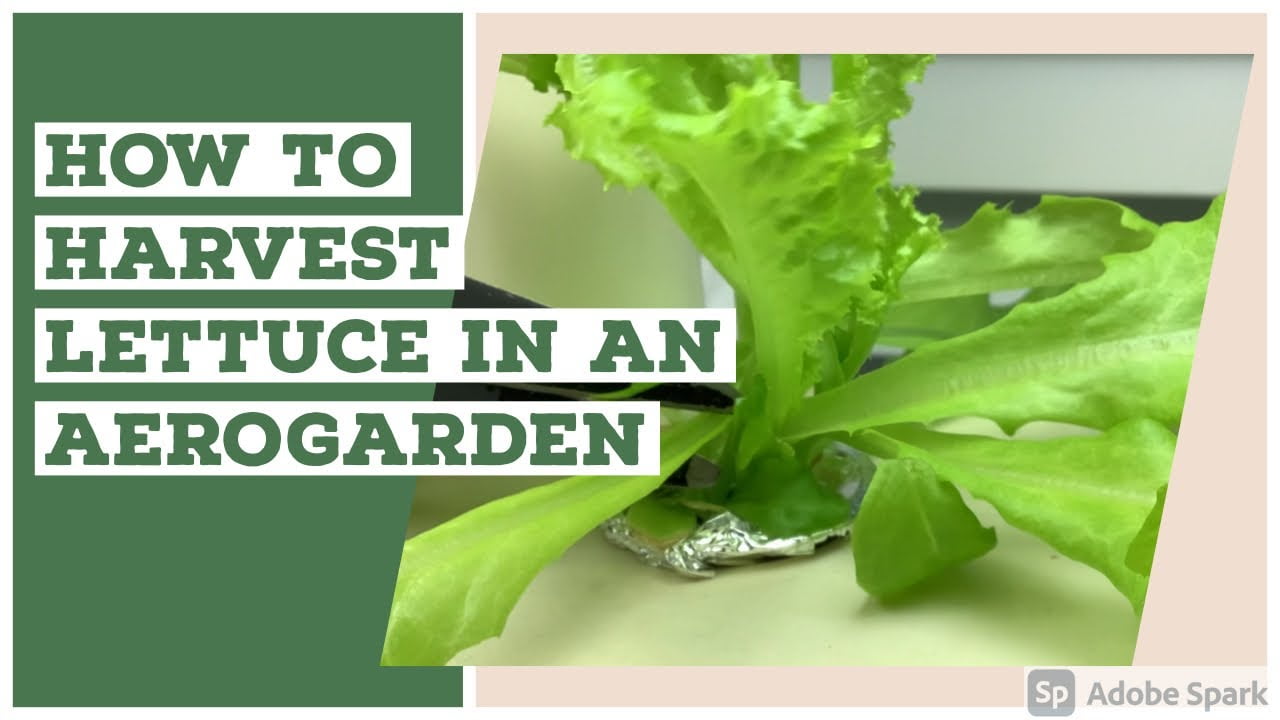So you’ve successfully grown lettuce in your AeroGarden, and now you’re ready to reap the rewards of your hard work. In this ultimate guide, we’ll walk you through the step-by-step process of harvesting lettuce from your AeroGarden. From choosing the right time to harvest to properly storing your leafy greens, we’ll provide you with all the essential tips and tricks to ensure a bountiful and delicious harvest. Say goodbye to store-bought lettuce and hello to fresh, home-grown goodness!
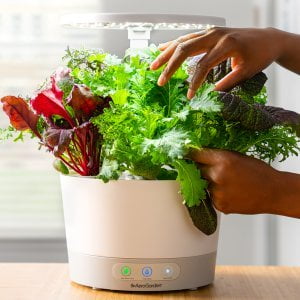
1. Choosing the Right Time to Harvest
When it comes to harvesting lettuce from your AeroGarden, timing is everything. You want to make sure that your lettuce has reached the optimal growth stage and is ready for harvest. There are a few factors to consider when determining the right time to harvest your lettuce.
Determining the Growth Stage
To determine the growth stage of your lettuce, examine the leaves carefully. Lettuce typically goes through several growth stages, starting from seedling and progressing to mature plant. Look for leaves that are fully developed, without any signs of yellowing or wilting. Once the leaves have reached their full size, they are ready for harvest.
Considering the Age of the Lettuce
Another important factor to consider is the age of the lettuce. While it might be tempting to harvest as soon as the leaves are big enough to eat, it’s best to give the lettuce some time to grow. The flavor and texture of the lettuce improve as it matures, so try to wait until it is at least 4-6 weeks old before harvesting.
Checking for Readiness
To check if your lettuce is ready for harvest, gently touch the leaves. If they feel firm and crisp, with no signs of wilting or brittleness, it’s a good indication that the lettuce is ready to be picked. Additionally, you can visually inspect the color of the leaves. Most lettuce varieties reach their peak when the leaves are a vibrant green color.
2. Preparing for Harvest
Before you embark on the process of harvesting your lettuce, it’s essential to gather all the necessary tools and ensure that they are clean and sterilized. Here’s what you’ll need to prepare for a successful harvest.
Gathering the Required Tools
To harvest your lettuce, you will need a sharp pair of scissors or garden shears. Make sure they are clean and in good condition to avoid damaging the lettuce leaves. Additionally, prepare a clean container or basket to collect the harvested lettuce leaves.
Sterilizing the Harvesting Tools
To prevent the spread of disease or pests, it’s crucial to sterilize your scissors or garden shears before using them to harvest lettuce. You can do this by soaking the blades in a solution of bleach and water for a few minutes, then rinsing them thoroughly with clean water. This simple step will help ensure the health of your lettuce plants.
Cleaning the AeroGarden
While not directly related to lettuce harvesting, it’s a good idea to clean your AeroGarden regularly. This will help maintain a hygienic growing environment for your lettuce and reduce the risk of disease or mold. Take the time to wipe down the surfaces, remove any debris, and check the water levels before and after each harvest.
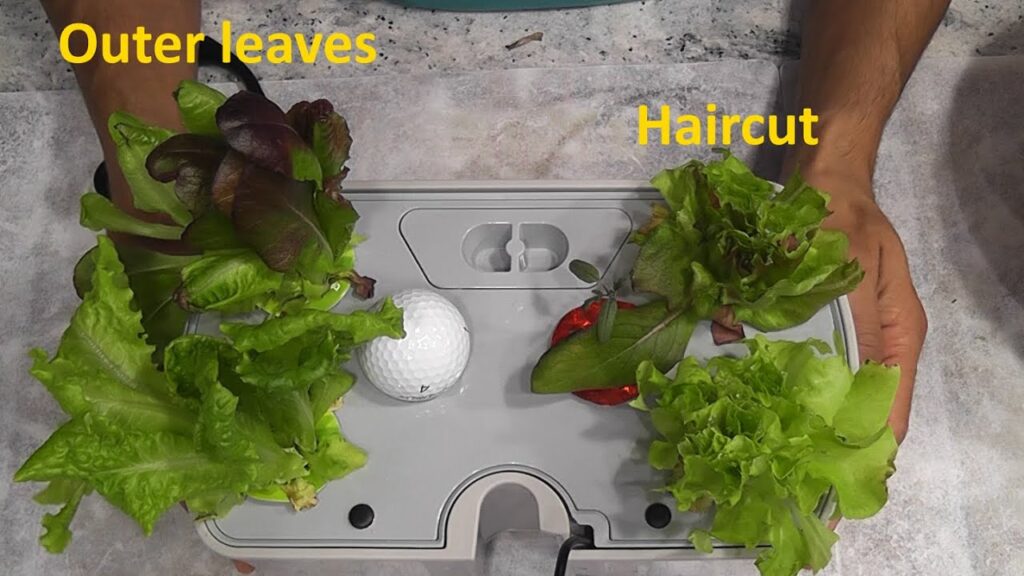
3. Harvesting Lettuce Leaves
Whether you prefer to harvest individual leaves or cut the entire lettuce plant, both techniques can be used to harvest lettuce from your AeroGarden. Let’s explore each method in detail.
Harvesting Individual Leaves
If you prefer a continuous harvest and want your lettuce plant to keep producing, harvesting individual leaves is the way to go. To do this, simply locate a fully grown leaf and cut it off near the base using sharp scissors or garden shears. Be careful not to damage the neighboring leaves or the plant’s crown. By selectively picking individual leaves, you allow new leaves to emerge, ensuring a continuous supply of fresh lettuce.
Cutting the Entire Lettuce Plant
If you wish to harvest a larger quantity of lettuce at once or if your lettuce plant has reached its maturity stage, you can opt to cut the entire plant. To do this, grip the lettuce plant near its base and carefully cut it just above the soil line. Make sure your scissors or garden shears are sharp to achieve a clean cut and avoid tearing the plant. This method is suitable when you need a larger quantity of lettuce for a specific purpose, such as making a salad for a gathering or preserving lettuce for later use.
4. Handling and Storing Harvested Lettuce
Once your lettuce leaves are harvested, it’s crucial to handle them with care to prevent damage and maintain their freshness. Proper washing and storage techniques are essential to ensure that your lettuce stays fresh for as long as possible.
Gentle Handling to Prevent Damage
Lettuce leaves are delicate, and rough handling can lead to bruising or wilting. To avoid damaging the leaves, handle them gently when harvesting and during subsequent steps. Be mindful of not squeezing or crushing the leaves, as this can accelerate spoilage.
Washing the Lettuce Leaves
Before consumption or storage, it’s important to wash the lettuce leaves thoroughly to remove any dirt, debris, or pesticides. Start by filling a clean bowl or sink with cold water. Submerge the leaves in the water and gently swirl them around to dislodge any impurities. Repeat this process at least twice, using fresh water each time. This will help ensure that your lettuce is free from contaminants and ready to be consumed.
Drying the Leaves
After washing, it’s crucial to dry the lettuce leaves properly to prevent excess moisture, which can lead to premature wilting or decay. One of the most effective methods is to use a salad spinner. Place the washed lettuce leaves in the salad spinner and spin it at a moderate speed to remove excess water. If you don’t have a salad spinner, you can gently pat the leaves dry with a clean kitchen towel.
Proper Storage Techniques
To prolong the shelf life of your harvested lettuce, it’s important to store it correctly. The key is to keep the leaves cool and moist without subjecting them to excess humidity. One effective method is to wrap the lettuce leaves loosely in a damp paper towel and place them in a sealed plastic bag or airtight container. Store the lettuce in the refrigerator’s crisper drawer, where the temperature and humidity levels are slightly higher than the rest of the fridge. This will help maintain the freshness and crispness of the lettuce leaves for several days.

5. Maximizing Harvest Efficiency
To make the most of your AeroGarden lettuce harvests, there are a few techniques you can use to maximize efficiency and prolong the plant’s productivity. Let’s explore some of these methods.
Harvesting Leaf by Leaf Method
By adopting the leaf by leaf method, you can prolong the harvest period of your lettuce plants. Instead of cutting the entire plant or taking multiple leaves from one plant, harvest a leaf or two from various plants in your AeroGarden. This allows the remaining leaves on each plant to continue growing, ensuring a continuous supply of fresh lettuce. Rotate between plants and harvest the outer and older leaves, which are usually more mature and ready for harvest.
Utilizing the Cut and Come Again Technique
The cut and come again technique is another efficient way to maximize your AeroGarden lettuce harvest. Rather than cutting the entire plant, trim the leaves just above the crown, leaving about an inch of growth. The remaining plant will continue to produce new leaves from the base, allowing for multiple harvests from a single lettuce plant. This technique is particularly useful when you need smaller quantities of lettuce at a time.
Encouraging Side Shoot Growth
To encourage side shoot growth and increase the productivity of your AeroGarden lettuce plants, it’s important to remove any flower buds that appear. When lettuce bolts or starts to produce flowers, the energy that would have been used for leaf development is diverted to seed production. By regularly inspecting your plants and pinching off any flower buds that emerge, you can redirect the plant’s energy towards leaf growth, resulting in a more bountiful harvest.
6. Harvesting Lettuce Seeds
If you’re interested in saving lettuce seeds for future plantings, it’s essential to allow your lettuce plants to bolt and produce seed heads. Let’s walk through the process of harvesting lettuce seeds.
Allowing the Plants to Bolt
Bolting refers to the natural process where lettuce plants start to grow tall and produce elongated flower stems. This usually occurs as the plants reach the end of their lifecycle. To allow your lettuce plants to bolt, stop harvesting the leaves and let them continue to grow. Soon enough, the plants will send up tall stems with yellow flowers.
Collecting Seed Heads
Once the lettuce plants have produced flower stems with yellow flowers, the seed heads will begin to develop. Wait until the seed heads turn brown and dry out before harvesting. Gently cut the seed heads off the plants, using sharp scissors or garden shears. Place the seed heads in a clean container or paper bag to continue drying.
Separating and Storing Lettuce Seeds
To separate the lettuce seeds from the seed heads, gently rub the dried seed heads between your hands or against a clean cloth. This will help release the seeds, which are small and light. To remove any remaining chaff or debris, you can use a sieve or strainer with fine mesh. Once the seeds are separated, store them in a cool, dry place in a labeled envelope or airtight container. Properly stored lettuce seeds can remain viable for several years, allowing you to continue growing your favorite varieties.
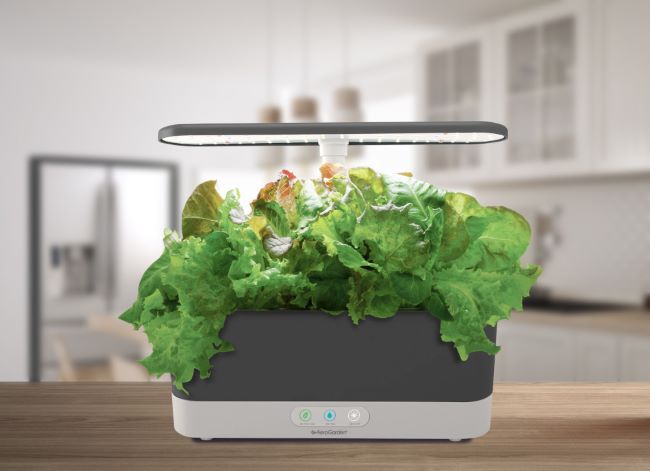
7. Common Harvesting Mistakes to Avoid
While harvesting lettuce from your AeroGarden is a relatively simple process, there are some common mistakes to watch out for. By avoiding these mistakes, you can ensure a successful and bountiful harvest.
Harvesting at the Wrong Time
One of the most common mistakes is harvesting lettuce too early or too late. It’s essential to wait until the leaves have reached their full size and the lettuce has matured. Harvesting too early can result in smaller, underdeveloped leaves, whereas waiting too long can lead to bitter or tough lettuce. Keep a close eye on the growth stage and age of your lettuce plants to determine the optimal time for harvest.
Damaging the Roots
When harvesting lettuce, it’s crucial to be mindful of the plant’s roots. Avoid pulling or tugging on the plants, as this can damage the delicate root system and hamper future growth. Instead, focus on cutting the leaves or the entire plant as close to the base as possible, while minimizing any disturbance to the roots.
Not Properly Storing Harvested Lettuce
Proper storage techniques are key to maintaining the freshness and quality of harvested lettuce. Failing to store lettuce correctly can result in wilted, soggy, or spoiled leaves. Remember to wash and dry the lettuce before storing it in the refrigerator using the methods outlined earlier. Additionally, make sure to consume or use the lettuce within a few days to enjoy it at its peak freshness.
8. Troubleshooting Common Harvesting Issues
While harvesting lettuce can be a rewarding experience, it’s not uncommon to encounter some issues along the way. Here are a few common harvesting issues and how to troubleshoot them.
Bitter or Tough Lettuce Leaves
If your harvested lettuce leaves turn out to be bitter or tough, it could be due to several factors. Bitterness often occurs when lettuce is harvested during hot weather or when the plants have bolted. To avoid this, ensure you harvest your lettuce during the cooler parts of the day and when the leaves are still young and tender. Additionally, growing lettuce varieties that are known for their sweetness and tenderness can help reduce the risk of bitterness.
Root Rot or Fungal Infections
Root rot and fungal infections can be a result of excess moisture, poor drainage, or contaminated soil. To prevent these issues, make sure your AeroGarden is properly maintained and the water levels are appropriate for lettuce growth. Avoid overwatering, as it can lead to stagnant water and promote fungal growth. If you suspect root rot or fungal infection, remove the affected plants immediately and adjust your growing conditions accordingly.
Declining Yield
If you notice a decline in the yield of your lettuce plants, it could be due to overcrowding or nutrient deficiencies. Overcrowded plants compete for resources and may not reach their full potential. To increase yield, thin out your lettuce plants by removing some of the seedlings to allow more space for the remaining ones to grow. Also, ensure that your AeroGarden’s nutrient solution is properly balanced and regularly replenished to provide the necessary nutrients for healthy growth.
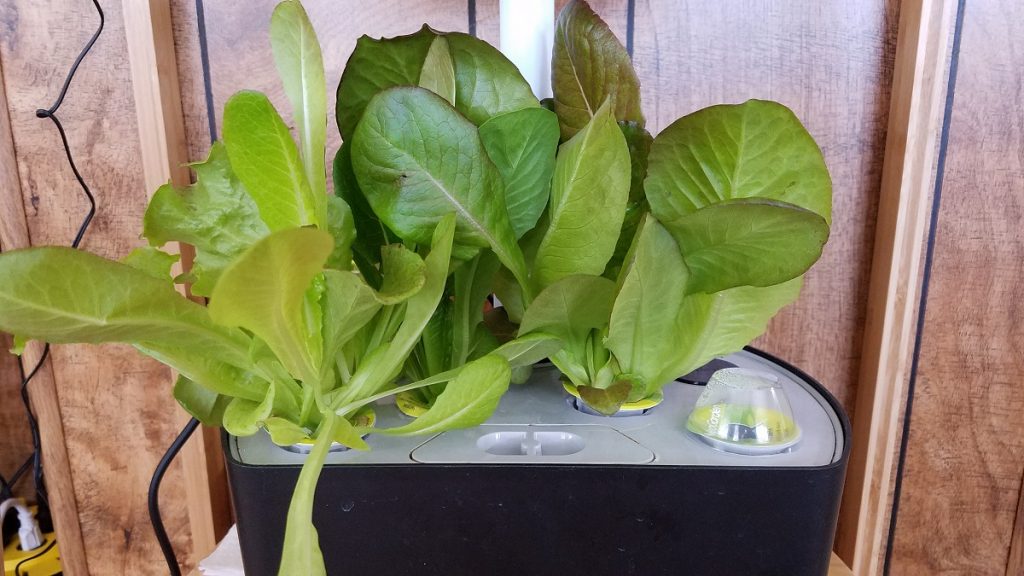
9. Utilizing Harvested Lettuce
Now that you have successfully harvested your lettuce, it’s time to put it to good use. There are numerous ways to enjoy freshly harvested lettuce, from simple salads to delicious culinary creations.
Preparing Fresh Salads
The most common and straightforward way to utilize your freshly harvested lettuce is by preparing refreshing salads. Combine the crisp lettuce leaves with your favorite vegetables, herbs, proteins, and dressings to create a variety of salads. From classic Caesar salads to colorful Mediterranean salads, the possibilities are endless. Experiment with different flavor combinations and textures to create your perfect salad.
Incorporating Lettuce in Various Dishes
Lettuce is not limited to just salads. It can be incorporated into a wide range of dishes, adding crunch, freshness, and a mild flavor. Use lettuce leaves as wraps for tacos, sandwiches, or burgers. Add them to soups, stir-fries, or stir into pasta dishes at the last minute for a burst of green goodness. Lettuce can even be used as a bed for serving grilled meats or roasted vegetables, adding both presentation and texture to your dishes.
Preserving Lettuce for Later Use
If you find yourself with excess harvested lettuce or want to enjoy the bounty of your AeroGarden throughout the year, consider preserving the lettuce for later use. One popular method is to blanch and freeze the lettuce leaves. Blanching involves briefly immersing the leaves in boiling water, followed by an ice bath. After blanching, pat the leaves dry and place them in freezer-safe bags or containers. Another option is to dehydrate the lettuce leaves using a food dehydrator or an oven set to low temperature. Once dehydrated, store the lettuce in airtight containers, and rehydrate as needed when ready to use.
10. Experimenting with Different Lettuce Varieties
Lastly, don’t be afraid to experiment with different lettuce varieties in your AeroGarden. There is a vast array of lettuce types, each with its own unique flavor profile and texture. From delicate butterhead lettuce to crispy romaine or vibrant red leaf lettuce, each variety offers a distinct culinary experience. Explore different varieties, grow them in your AeroGarden, and enjoy the diversity of flavors and textures that lettuce has to offer. It’s an exciting way to expand your palate and discover new favorites.
In conclusion, harvesting lettuce from an AeroGarden can be a rewarding experience that allows you to enjoy fresh, homegrown lettuce whenever you desire. By choosing the right time to harvest, preparing properly, handling and storing with care, and utilizing efficient techniques, you can maximize your lettuce harvests and avoid common mistakes. Troubleshooting and experimenting with different lettuce varieties adds to the learning and culinary adventure. So, grab your scissors, harvest your lettuce, and get ready to savor the joy of homegrown greens straight from your AeroGarden.
